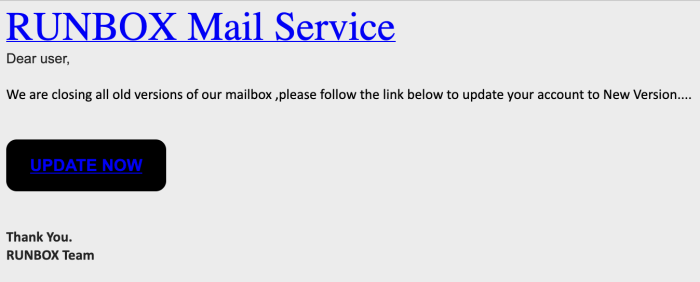This constitutes a major upgrade to the framework and libraries that Runbox 7 is built on, which will facilitate further continuous upgrades and features.
It also includes several bug fixes and improvements, including storing display preferences on the server. This will make the user interface work more consistently across browsers, devices, and sessions and result in a more streamlined experience.
- Internal changes (deps): bump ua-parser-js from 0.7.31 to 0.7.33 (75df34d)
- Internal changes (deps): bump jszip from 3.7.1 to 3.10.1 (ef32ab1)
- Bug fix (drafts): Ensure we only refresh drafts once per folders update (f024af2)
- Bug fix (delete): Catch/Prevent more errors by ensuring defaults (5e83f89)
- New feature (mailviewer): Display incoming attachment sizes (926ab4b)
- Bug fix (compose): More readable attachment file size display (e44fc63)
- Visual changes (security): Specify which special characters are allowed in passwords. (#1401) (c575f06)
- Internal changes (deps): Update angular2-hotkeys to v13 (85aee64)
- Internal changes (deps): Upgrade to angular 12 (11b3aeb)
- Internal changes (deps): Update nodejs version for CI (a5cd077)
- Internal changes (deps): Upgrade angular-datetime-picker (2a87817)
- Internal changes (deps): Upgrade to v13 (4c744c1)
- Internal changes (deps): Change swupdate.available to swupdates.versionUpdates (ad7b36a)
- Internal changes (deps): Move from tslint to eslint (c010fca)
- Internal changes (deps): Remove –aot for start-use-mockserver (08afe91)
- Internal changes (deps): Remove SingleMailViewerComponent from rmm6.module.ts (ddebc3f)
- Internal changes (deps): Upgrade cypress to 9.7 (c38f460)
- Internal changes (deps): Update ical.js to 1.5.0 and use ES2020 modules (9bf6dda)
- Internal changes (deps): Fix selectFile file path (ee83c8f)
- Internal changes (deps): Update dependant packages (2c11d60)
- Internal changes (deps): Upgrade to angular v14 (cddac42)
- Internal changes (deps): Explicitly specify runbox7 for build (1b07233)
- Internal changes (deps): Upgrade angular/material to v13 (adef6c3)
- Internal changes (deps): Revert to angular/material v11 for auto upgrade (97f89cc)
- Internal changes (deps): Manually upgrade to angular material v12 (3e04baa)
- Internal changes (deps): Upgrade material to v13 (3096d97)
- Internal changes (deps): Upgrade angular-datetime-picker to v14 (3876111)
- Internal changes (deps): Upgrade to material v14 (c280c39)
- Internal changes (deps): Fix missing hues for SCSS (6a916d5)
- Internal changes (deps): Update @angular-eslint packages (8b0c16f)
- Internal changes (deps): Upgrade to angular v15 (2374336)
- Internal changes (deps): Upgrade to angular material v15 (6dc73b2)
- Internal changes (deps): Remove duplicate @include from SCSS (b35a68a)
- Internal changes (deps): Change default browser for CI to firefox (ab522f6)
- Internal changes (deps): Upgrade npm, comment out pre-build.js integrity check (ff13958)
- Internal changes (deps): remove –browser firefox from e2e tests (ab8b437)
- Internal changes (tests): Add DISPLAY=” to ci-tests (8441a51)
- Internal changes (deps): Remove unused protractor dependency (6e0f935)
- Internal changes (deps): Upgrade core.js to v3 (7aa65d3)
- Internal changes (deps): Remove unused protractor files (b7c312b)
- Internal changes (deps): Upgrade @angular-devkit/build-angular and move angular/compiler-cli to devDependencies (4cd4bc2)
- Internal changes (deps): Remove unused ajv dependency (b447972)
- Internal changes (deps): Upgrade angular-calendar (a273376)
- Internal changes (deps): Update rxjs to v7 (a87c0b3)
- Internal changes (deps): Upgrade @angular/pwa (d4850f0)
- Internal changes (deps): Remove array-flat-polyfill (8c527d8)
- Internal changes (deps): Update moment-timezone and remove uneeded @types/moment-timezone (478eb5a)
- Internal changes (deps): Update rest of dependencies (excluding timymce) (5ed129b)
- Internal changes (deps): Update jasmine to latest version (d0084df)
- Internal changes (deps): Upgrade karma to latest version (da8a151)
- Internal changes (deps): Update ts-* deps and node types (0b7abb4)
- Internal changes (deps): Update start-server-and-test (ee77754)
- Internal changes (deps): Update eslint and @typescript-eslint (4285f0d)
- Internal changes (deps): Update cypress to v10 (d350af9)
- Internal changes (deps): Update cypress to v11 (480b506)
- New feature (all): Store user preferences on the server (1409515)
- New feature (compose): Store last used HTML compose setting (dc1a75e)
- Bug fix (mailview): Store “prompted for local index” preference on server (0d9085e)
- Internal changes (preferences): Ensures tests set defaults, test correct values (035f28c)
- Bug fix (preferences): Remove old style local storage after conversion (7ca13b7)
- Bug fix (preferences): Ensure higher server version takes precedence (d8766f8)
- Bug fix (preferences): Load screensize before settings (da76123)
- Internal changes (deps): Update cypress to v12 (4ba7f7e)
- Internal changes (lint): Only include src/ else we run out of js heap memory (f359c38)
- Internal changes (deps): bump @npmcli/arborist and npm (9cf4279)
- Bug fix (compose): Generate Reply/Fwd header text only when needed (7afcbf7)
- Bug fix (compose): Convert reply/fwd text if compose HTML default is on (c512556)
- Bug fix (maillist): Store and reload column widths from preferences (cfb732d)
- Visual changes (preview): Improve formatting of the empty preview pane. (60fcacf)
- Visual changes (mailviewer): Increase vertical flexibility of subject field. (364272b)
- Visual changes (mail menu): Improve read and unread icons. (93e75ae)
- Bug fix (changelog): Add missing categories and improve formatting. (fd5c902)











